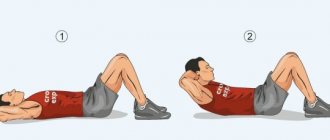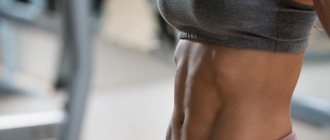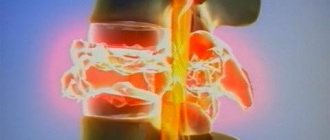Anyone who cares about the beauty of their body is sure to pay attention to the abdominal area. In this regard, questions arise: how and at what time is it better to pump up the press. It’s right to be interested in such things; training at the wrong time can not only waste your energy, but also harm your health. In this article we will look at what period is optimal for training, and we will look at proper breathing when performing abdominal exercises. You will learn about the physiological differences between men and women and the associated features, and you will receive recommendations for organizing training.
Useful tips on this topic await you in the article “How to pump up abs of steel?” To decide on a training routine, you need to understand the difference in the structure of the male and female body.
What happens when you pump your abs
Abdominal muscles, like any other muscles in the body, can be trained. To do this, it is important to select an adequate load and perform exercises with the necessary regularity. After all, if you do crunches once a week, you won’t get any effect.
What will regular training give you?
- Your posture will become correct. The abdominal muscles directly affect posture - they prevent a person from crouching. Moreover, correct posture will appear by itself, you will not have to make much effort and watch how you sit or walk.
- The internal organs will fall into place and will not move. The sedentary lifestyle that many of us lead leads to the fact that some internal organs are slightly displaced from their places. At first, this does not affect your health, but over time, compression of organs may occur. A strong and pumped up press allows you to prevent this.
- The body becomes stronger and more resilient.
Doing abdominal exercises at home or in the gym is real
Effective ab workout
1.Train your abs at the very beginning of your workout.
If the press is a weak point, put it No. 1. This is done specifically while the body is full of strength and energy, because at the end of the training process there will be practically no strength left for the press and you will not work it to its full potential, or you will simply spit and leave because there is so much I left my strength in the gym. Also, sometimes between heavy sets of basic exercises, instead of resting, train your abs; this will bring results since the number of repetitions by the end of the workout will be huge.
2. Basic exercises do not mean that you don’t need to train your abs
Indeed, in basic exercises, the abdominal muscles receive a load while holding the spine in the correct position, creating a so-called muscle corset, and it would seem that the question of how to pump up the abdominal muscles has been practically resolved, but not everything is so simple. In this case, the muscles are tensed isometrically at certain angles, and the abdominal muscles need to be trained from different sides, so separate abdominal training is mandatory.
3.Train with a heavy load
The abdominal muscles have a huge number of slow-twitch muscle fibers, so they need to be trained with a large number of repetitions, but every 3-4 workouts, train them for 12 repetitions using weights, for example, using the exercise - twisting on a block, and also do not forget about the abdominal wall lying inside the abdomen between the abdominal muscles and internal organs using an exercise - a vacuum, this is what prevents the effect of a prolapsed belly.
4. Pump up your abs with the heaviest exercise
As in training other muscles of the body, give first place to the most difficult and uncomfortable exercise, which takes a lot of strength, this is how you will work out the perfect abs, leaving your favorite exercises for last.
5.Make a clear plan for training your abs
You shouldn’t pump up your abs with an arsenal of 1-2 exercises all the time, make a list of 6-7 exercises and change them every time, only this way the abs will get 100% development and the problem of how to pump up your abs muscles will be solved faster.
6.Learn to feel your upper and lower abs
This is important to do correctly, when performing crunches, feel the upper abs, linger at the highest point and feel how the abs contract and tense, when lifting your legs, feel the bottom of the abs, to do this, avoid swaying of the body, raising your legs as high as possible. Once you learn this, you'll be one step closer to creating super abs.
7.Use a progressive load
Don’t constantly do the press for your favorite 15-20 repetitions, get out of your comfort zone, trying to perform more and more repetitions or approaches, this way the press cannot get used to the load and will respond to a new challenge every time, only in this way the muscles will constantly improve.
8. Don't forget to give your abs a break.
Training your abs every day, or even several times daily, does not mean it’s good; it’s better to train it every other day, while doing your best in training. Constant stress on the abs without sufficient rest will lead to overtraining, which means that progress will automatically stop and the time for muscle recovery will take a long time, and this is a step back in creating a beautiful belly.
9.Hold your breath as you exhale
Holding your breath at the very end of the exercise increases abdominal pressure, which allows you to better feel the muscle and contract it as efficiently as possible. A complete exhalation should only occur at the very end of the exercise.
10. Get over the burning sensation
At the end of the exercise, the abdominal muscles begin to burn, as if boiling water was lightly poured on them, this is a normal feeling that means that the muscles are receiving a good load. Learn to cross this pain threshold, going beyond the impossible, thus the most dormant muscles will be included in the work, and the abs will be transformed from workout to workout.
Turn on Tabata training
The point is this: you don't focus on the number of repetitions, all your attention is tied to time. Tighten your abdominal muscles for 20 seconds, then 10 seconds of rest, again the load for 20 seconds and 10 seconds of rest, and so on until you can no longer do the exercise.
12. Eliminate errors
— When lifting your body, do not straighten your spine, round your back as much as possible, pay full attention to the abdominal muscles, otherwise part of the load will go to the lower back.
— When performing twisting, do not help yourself with your hands, dragging your head with your hands, your fingers lightly touch your head and nothing more.
— When you lift your body on an incline bench, relax your lower body as much as possible, do not strain your thigh muscles, this takes part of the load from the abs.
13. Don't look for exercise relief
— At the final contraction of the press, perform a 1-2 second delay.
— Abdominal contraction occurs at a fast pace, and relaxation occurs at a slow pace.
— When twisting, the range of motion is minimal, the abdominal muscles must be tense all the time, so when relaxing, do not let your shoulder blades rest on the floor.
14. Diet is everything
And probably one of the most important rules on how to pump up your abdominal muscles, without proper nutrition, you can forget about sculpted abs, even spend the night in the gym, do 1000 repetitions, you will have abs, but hidden from prying eyes under a layer of subcutaneous fat.
Adopt these 14 rules and your abs will experience a second youth
When is the best time to pump up your abs?
Many people do not know that at different times of the day our body reacts differently to physical activity. And they don’t even think about when it’s better to pump up the abs: before or after meals, in the morning or in the evening?
According to trainers, the optimal time for crunches is in the morning before breakfast. But after drinking a glass of water on an empty stomach. Morning comes at different times for everyone, so no one will tell you what time it is best to pump up your abs.
However, we all wake up differently. And we don’t feel the same in the morning either. Many people prefer to sleep an extra half hour instead of working out. In this case, you can do crunches in the evening. It will be much better than not doing them at all. The optimal time in this situation is approximately 1.5 hours after dinner and a couple of hours before bedtime.
How to breathe
Proper breathing during crunches helps you achieve the desired results faster. You don't just strain your muscles during exercise - you give them additional stress.
Most novice athletes involuntarily hold their breath while doing crunches. In this case, the muscles do not receive the necessary amount of oxygen, and you do not get the maximum from your workout.
How do you need to breathe correctly, why do you burn fat and lose weight if you do everything according to the instructions? With uniform and calm breathing, a sufficient amount of oxygen reaches the muscles. Therefore, fatigue appears much more slowly, which increases the effectiveness of the training.
The correct breathing technique is very simple - during relaxation you need to inhale, and during maximum muscle tension, exhale.
How to eat when you're doing abs
When training regularly, a lot depends on the foods you eat. If you do not follow a diet, you will wait a very long time for noticeable results. And perhaps you won’t wait. What can and cannot be eaten when working out your abs, what to eat when you are losing weight and what is the diet when gaining weight and is it difficult to eat right every day? You will have to deal with all these issues on your own or with the help of a nutritionist if you want to end up with beautiful six-pack abs. After all, without proper and balanced nutrition, your workouts will not be as effective as they should be.
Sample menu for a flat tummy
The principles of nutrition are approximately the same as for normal weight loss, recalls Losing Weight Without Problems: drink enough water, exclude sweets, fast food, alcohol and other harmful foods. However, there are also differences.
- At least a third of your diet should be protein. This includes lean meat, vegetable protein, dairy products, and fish. If you are not ready to eat that amount of protein, you can use protein as a dietary supplement.
- It is very good to introduce nuts into your diet. Although they are quite high in calories, they are very useful.
- Add fish oil to your diet. You can increase the amount of fish in the menu, or you can buy fish oil in capsule form at the pharmacy.
The rest of the menu does not differ from the principles of healthy eating. Try not to eat fast carbohydrates, give up fried foods, eat more vegetables and fruits.
Relationship with meals
This issue deserves special attention. First of all, you need to understand that intense training is not compatible with fasting. There must be a balance between energy consumption and restoration; if you do not maintain it, the consequences can be different, from the appearance of excess weight to overtraining and painful exhaustion of the body. The optimal time for exercises aimed at the stomach is 2-3 hours after eating. As mentioned above, you should not borrow on a full stomach.
With this routine, you will be able to have your next meal right after the training, but not immediately, but after about half an hour.
Working on your belly involves not only physical activity, but also proper nutrition. You should avoid excessively fatty and high-calorie foods, carbonated drinks, fast food and other junk foods. All this contributes to the formation of a fat layer, which will not allow you to see the cubes. It is also not recommended to overindulge in salty and sweet foods; such foods provoke swelling of the tissues, this is another reason for the increase in volume. You can study other useful recommendations in the article “How to pump up the most powerful abs.”
Why does the belly get bigger?
Why, when you pump up your abs, does your stomach become a house or stick out in the middle and get bigger? Some girls who have just started training are surprised when they see that after regular training the volumes only increase. Some even quit classes without trying to figure out what is happening in the body. There are several reasons for belly growth.
- The abdominal muscles begin to increase from training, and the fat disappears slowly. Because of this, a small bump may appear in the abdominal area.
- A person exercises regularly, but does not follow a diet. And due to the absence of a calorie deficit, his fat layer does not go away.
- Incorrect technique for performing crunches leads to the fact that completely different muscles are trained.
Abdominal enlargement is especially noticeable in obese people who have not previously engaged in physical activity.
However, hudeem-bez-problem ru reminds you that such an increase is temporary if all the recommendations of nutritionists and trainers are followed. Over time, the fat layer will go away and the abs will gain definition.
Myth No. 1: If you pump up your abs, you will lose belly fat.
Myth No. 1: if you pump up your abs, you will lose belly fat (photo: @joja) This is a fundamentally wrong opinion: this exercise tones the rectus abdominis muscle well when performed perfectly. But this does not mean that the volume will decrease: on the contrary, the belly will only become larger. In order to effectively work on the problem area, in particular the stomach, you first need to adjust your diet and reduce the number of calories consumed. Secondly, you need to train your whole body, including doing the following exercises.
Breathing exercises
Starting position:
lie on your back, legs bent at the knees, shoulders pressed to the body. Take strong inhalations and exhalations, bringing the costal arches together.
Plank with hip extension
Initial position:
knee-elbow position. Straighten your knees into a plank position and hold this position for 5-10 seconds. Lower your knees to the floor for a few seconds and then return to a plank position on your elbows. Repeat the exercise 5-6 times.
This set of exercises must be performed regularly, then the extra pounds will quickly go away, and you will get a strong, sculpted body.
How to increase muscle mass without looking over-pumped: expert opinion Read
When to pump up your abs after natural childbirth?
Even one woman can have completely different births. For example, the first child appeared easily and quickly, but during the birth of the second, problems arose and the birth dragged on for several hours. Therefore, only a gynecologist can answer the question of when you can start pumping up your abs after childbirth.
It’s quite possible to train your abdominal muscles on the couch
He needs to assess the condition of the uterus, because you can start exercising only after it returns to its natural state. Plus, the state of the body’s hormonal levels plays a big role.
On average, after a natural birth, you are allowed to start training after about 2 months.
But be sure to monitor your condition during classes. Exercise should not cause pain or severe discomfort. There should be no bleeding or any other non-specific symptoms. If any of the above occur, stop training and consult a doctor.
Local fat burning - myth or reality
From time to time, in sports circles, debates flare up about local fat burning (scientifically, spot reduction).
The essence of the phenomenon is to reduce its amount in a particular part of the body without changing the overall percentage of fat! For example, only in the abdominal area.
On the one hand, the laws of physiology say that this is impossible. If the percentage of body fat decreases, then it decreases everywhere! And all parts of the body lose weight.
On the other hand, there is a lot of scientific evidence that body parts may lose weight unevenly! That is, the arms lost 2%, and the abs – 5% (over the same period of time).
It is on this fact that local fat burning techniques are based.
And one of the key factors of such techniques is daily training of the problem area!
For example, you urgently need relief abs. Then, according to the local fat burning method, you will need to pump up your abs every day! And according to some of the methods, 3-5 times a day!
They say that history develops in a spiral. So we're back in the 60s?
In a spiral - yes, but this is a qualitatively new round of development one level higher.
Unlike the 60s, there is an understanding of the fat burning process. And even with local fat burning, the key factor is the CORRECT DIET! Methodology comes second!
The performing athletes have closed this question for themselves long ago. Practice shows that when there is a high percentage of fat in the body, local fat burning is not effective. The basic laws of physiology triumph.
If the body has already reached a low percentage of fat, then local fat burning is possible. Supporters of point reduction are triumphant.
When to pump abs after cesarean
Usually doctors try to ensure that the child is born naturally. Therefore, caesarean section is prescribed for various problems. This could be a multiple pregnancy, abnormal placement of the fetus, etc.
If the caesarean section took place in a standard manner, then the attending physician advises resuming training no earlier than 3-4 months after the operation. But if there were any complications, for example, suture dehiscence, hernia or something else, then the start date for training may be postponed indefinitely.
The first abdominal workouts after cesarean section should be started with caution and constantly monitor your condition. There is no need to overload your body - it will be much more beneficial for it to train with low intensity, but at the same time regularly.
When can you do abs after surgery?
When can you tense your stomach and pump up your abs after laparoscopy, appendicitis removal and other abdominal surgeries? Laparoscopy is an operation that is performed using punctures in the abdominal cavity. Nowadays, appendicitis and small fibroids are removed using this method. Since this is a minimally traumatic intervention, it will be possible to start practicing earlier than with abdominal surgery. But it is necessary for the doctor to evaluate how the internal organs endured the intervention, and whether there will be bleeding if stress is applied to the abs.
With the least traumatic operation, during which there were no surprises, it is allowed to start training a month after discharge from the hospital. But such a good outcome is quite rare. Therefore, count on a period of 2 months.
If abdominal surgery is performed, for example, for intestinal peritonitis or removal of the uterus, then the healing period increases significantly.
You need to wait not only for the suture to heal, but also for all the internal organs to begin functioning as before. The average recovery time is six months.
What muscles are involved when performing abdominal exercises?
What time to study?
It is best to contact a competent trainer with all questions regarding the organization of training. The advantage of this approach is that the specialist will give personal recommendations based on individual characteristics. To get a universal answer, you don’t have to sign up for a lesson with a trainer.
It is impossible to say unequivocally at what time of day it is better to pump up the press. All people live according to their own regimes, some are incredibly cheerful in the morning, others gain strength only in the afternoon. You should choose the time for training in accordance with your daily routine. During this period, you should be energetic, feel good, and be in a positive mood.
Many experts say that it is better to work on the abdominal muscles in the morning. It is believed that training to get rid of fat deposits should be done before breakfast. In this case, we are interested in the growth of muscle tissue, so we should not stimulate them on an empty stomach. In addition, the exercises are quite energy-intensive; the body requires calories to perform them.
You definitely shouldn’t exercise your abs at night or in the evening right before bed. During this period, the body should gradually relax and adjust to rest. The training will be very invigorating, you will not be able to sleep in the next few hours, which will ultimately lead to insomnia. Insomnia, in turn, provokes chronic stress, which not only harms overall health, but also stops muscle growth. Also, do not do this immediately after eating. The pressure that forms in the abdominal cavity does not contribute to proper digestion, and the consequences can be nausea and vomiting.
My neck hurts when I do crunches - what to do?
Beginners are surprised that when they do abs, their neck starts to hurt, not their muscles or body. But for those who have been doing crunches for a long time, this is not surprising. The fact is that beginners often make mistakes in the technique of performing this exercise. They begin to work not with the abdominal part of the body, but with the upper part. Or your torso may be lifting when doing the crunch, but your neck is not working in sync, causing pain symptoms.
There are several options for solving the problem.
- The first is to work out the correct technique with a trainer and then during training, concentrate and do everything as correctly as possible. It is very good if the trainer can observe you for several sessions and control the correctness.
- The second option is to imagine that between your chin and chest there is an apple that needs to be held while twisting. Or put a rolled up towel there.
- The third is to take a roller and place it under your back just below your shoulder blades. This will provide support to your upper back.
Why does your stomach hurt from crunches?
There may be several reasons for the appearance of abdominal pain. And you need to understand what kind of pain it is in order to try to determine the cause. Often the stomach hurts due to improper exercise technique or too much stress on the abs. But in this case, it is the abdominal muscles that will hurt. The pain will be slightly worse when these muscles are tense, for example when laughing.
Such pain is not pathological, however, the load should be selected more correctly and the technique of performing twists should be monitored.
But there is also pathological pain that appears in some diseases. First of all, these are diseases of the digestive system: gastritis or ulcers. When doing a crunch, the stomach is compressed, which leads to pain. Be sure to consult a doctor if you have already been diagnosed with these diseases. And you also need to visit a doctor if the abdominal pain is very acute, or tolerable, but does not go away within a day after training.
How to relieve pain in the abdominal muscles after a workout >>
Training your abdominal muscles depends on how you work the other muscle groups. In some, for example, the abdominal muscles have a high ratio of slow fibers to fast fibers compared to other muscles. Even a small layer of fat can hide the definition of your abs, so following a diet is essential in any case.
Based on my experience, I can say that there are several competent approaches to training the abdominal muscles, and some of the existing methods are not very effective. I was asked to make a list of the most important points in training the abdominal muscles, which we called “laws”. I hope you can take something valuable from this list and put it into practice in your training:
- #1: If your abdominal muscles are your weak point, train them at the beginning of your session.
At the beginning of your workout, your energy level is at its highest. If you wait until the end of the workout, you run a very high risk of leaving the gym without training your abdominal muscles at all. Another method that works is to train the abdominal muscles between sets of exercises for large muscle groups. Maybe not between sets of your heaviest leg sets, but in other parts of your workout this strategy is effective because... Abdominal exercises do not put much strain on your respiratory and nervous systems. In my case, the abs are already the dominant muscle group. He's gotten that way over years of training, so I can load him up at the end of class. Honestly, if I skip an ab workout, nothing will change in my life. - No. 2: Heavy compound exercises are not a replacement for isolated abdominal work.
When you do heavy compound work like deadlifts, bent-over rows, military presses, and Romanian deadlifts, the abdominal muscles work extra to maintain a secure back position. As a result, they receive a significant amount of work even on days when you don't do isolated ab work. However, in most cases this is isometric work - the muscles keep the back straight, while they do not stretch or contract. This kind of load builds force, and quite a specific one, when working at a certain angle. Thus, heavy basic exercises do not replace direct work with the abdominal muscles, but only complement it. Yes, the abs don't require as much direct work as the quads or chest. Like your calves and biceps, your abs are a small muscle group that doesn't require a large amount of training to stimulate.
- #3: To build abdominal muscles, train with heavy weights.
Despite the high percentage of slow-twitch muscle fibers, the abs still need to be trained in the range of 8-12 repetitions. This is what I do to make my abs look like rocks. This appearance only happens if the cubes stick out and have mass. To work with the inner wall of the press, which is invisible, I use static tension for 30-60 seconds. - #4: Start with the heaviest exercise.
As you get tired during your workout, you can do exercises that are easier for you. If you train like I do, you will have a vacuum exercise at the end, or you can do it between sets of movements for other muscle groups.
- #5: Train your abs by following a plan.
I have a set of 5-6 exercises that I can do at any time. Through trial and error, I have found that these exercises produce better results. I don't need more exercise to achieve the look I want. Depending on which machines are available in the gym, I do 2 exercises with additional load and another one - static, like a vacuum. In general, I think that three abdominal exercises per day is enough. - #6: Isolate the top and bottom of your abs.
For my upper abs, my favorite move is the cable crunch. To work the upper body in isolation, stabilize your lower body while crunching your upper body down. You can practice this skill by doing cable crunches while lying on the floor without your lower body moving. During hanging leg raises, the opposite happens: the upper body is fixed, you lift your legs up, imagining the opposite movement to what it was during crunches. The key point of the exercise is movement only in the hip joint. - #7: For maximum results, use weights or other forms of resistance.
I do almost all abdominal exercises with additional load. This allows you to train in a lower rep range, which breaks down the muscle fibers to a greater extent. In my opinion, the biggest mistake people make when training their abs is doing too many reps without using additional resistance, such as bodyweight movements. You need extra resistance if you want to thicken your six-pack and create a voluminous bulge in your abs. - #8: Work your transverse abdominis.
I would say that the most underrated exercise is the vacuum, which works the transverse abdominal muscles. These muscles are not visible under the skin. Consider doing a standing vacuum like Frank Zane did. As you do this, you pull your belly back toward your back—this movement helps increase the strength of your abdominal wall. Just pull your stomach in and hold it in this retracted position. There really needs to be a brain-muscle connection. You can even consciously draw your stomach toward your back as you perform almost every exercise. For example, when I do triceps on the block, I keep my stomach extremely retracted. It's easy to vacuum between sets of larger muscle groups, but this should be in addition to direct abdominal work.
- #9: Always try to improve what you did before.
Progressive overload is just as important when training your abdominal muscles as it is for any other muscle group. Don't just do your 3 sets of 15 reps over and over again. Try to do more repetitions each workout; As strength increases, increase the weights. - #10: Give your abdominal muscles adequate recovery time.
I don't think it's right to train your abs every day, because it doesn't leave time for recovery and growth. Although the abdominal muscles are a small group that recovers quickly, I prefer to work them 3 times a week, or every two days. Remember that the abdominal muscles receive indirect load during other exercises, so 3 direct workouts per week is a good place to start if the abs are your weak point. If not, then I would recommend training it 1-2 times a week.
- #11: Hold your breath for a stronger contraction.
Breathing is just as important when training your abdominal muscles as it is with other muscle groups. Hold your breath as you complete the contraction. This will maintain intra-abdominal pressure, giving you a significant strength advantage over exhaling during the final phase of each rep. Exhale only at the very end of the amplitude. Of course, you need to inhale while lowering.
- #12: Learn to ignore the burning sensation in your muscles.
It doesn't take much imagination to train your abdominal muscles. Just give it some heat! When it starts to burn, press on! No matter how many of your friends cheer you on, at this moment you are fighting with yourself. We are talking about willpower here. - #13: Use Tabata to make your workouts harder.
I'm a Libra, so I don't like to leave opportunities unused. I don't just do 3 sets of 15-20 reps and move on to the next exercise; I really want my abs to start burning. I use the Tabata technique, where after 20 seconds of work followed by 10 seconds of rest. This is repeated for 4 minutes, so during this time I do 8 approaches. You need to make sure that you are using the right load because you need to feel the burn in those 20 seconds, doing 8-12 repetitions during this time. In the first few sets there will be no burning sensation, but on the seventh or eighth there will definitely be. If you still don't feel a burning sensation, you're probably training your abs incorrectly. - #14: Use cluster sets.
Cluster sets work the same way as Tabata sets. You need to push your abdominal muscles to the limit, rest a little, and then load them again. For cluster sets, I work for about a minute, doing as many reps as possible with the given weight. After this, I rest for 30 seconds, instead of a couple of minutes, as is the case with other parts of the body, and repeat the set again. - #15: Stick to proper technique.
With the right technique, you will develop your abdominal muscles faster and avoid injury:
- Twist your back - don't keep it straight. A straight back is good for almost all other exercises in the gym, but not for training the abdominal muscles.
- Relax your hip flexors as you do incline crunches. Engaging these muscles reduces the load directly on the abs.
- Don't pull your head when doing bodyweight abdominal exercises.
- #16: Don't look for easy ways
. You want to increase muscle stress, not decrease it. Here are a few ways to make the load heavier: Hold the peak contraction instead of immediately starting the negative phase of the movement. - Reduce the speed of repetitions; Use a smooth, careful movement to reduce the impact of the momentum from the swing.
- When doing abdominal exercises on the floor, never let your shoulders touch the floor between repetitions - this will take the stress off the muscles.
. Abs are not made in the kitchen, they are made in the gym through hard training. But your abs become visible as a result of your diet. You can train your abs every day, or even 10 times a day, but if you have a crap diet, you will never see six-pack abs. They may be there, in place, but hidden by fat.
- #18: Burn extra calories with HIIT (high-intensity interval training).
I can have defined abs without even taking a step on the cardio equipment. However, for most people who want to reduce their body fat percentage, aerobic exercise can help achieve a calorie deficit in the body. If you choose from types of cardio training, then HIIT is the best because it allows you to burn much more calories, both directly during the workout and within a day after it (compared to regular cardio). Tabata works similarly to HIIT: work for 20 seconds, rest for 10 seconds. Whether you lift weights or do cardio, Tabata can be an effective fat burner. At the same time, we eliminate the boredom factor from a whole hour spent on a cardio machine.
Translation:
Liked? Share with your friends!
Back pain, lower back from twisting
About every fifth person feels pain in the back or lower back at the moment when they pump their abs. There may be several reasons for this, but almost all of them are pathological. This may be a pinched or inflamed nerve, intervertebral hernia, deformation or abrasion of intervertebral discs and other pathologies. There are only two physiological reasons: incorrect exercise technique or weak muscles that cannot ensure correct body position. What to do when your back or lower back hurts, if you do crunches for a hernia or other problems. Consult a doctor, because the cause may be very serious!
How to pump up your abs during your period
In general, doctors and trainers say that sports during menstruation are not prohibited. However, you should listen to your body. If you have heavy periods, which are accompanied by pain, then these days it is better to refuse not only abdominal exercises, but also any physical activity. It is also recommended to abstain for those whose menstruation lasts more than a week.
If there are no unpleasant manifestations, and you feel no worse than on other days, then there are no restrictions for you. You just need to monitor your condition a little more carefully in order to notice unpleasant symptoms in time if they appear.
Crunching exercises will help you achieve six-pack abs if you follow the technique, exercise regularly and normalize your diet. Not everyone is ready to radically change their life for the sake of a beautiful body, but if you decide, then hudeem-bez-problem.ru is sure that the reward will be not only beauty, but also health.
130











